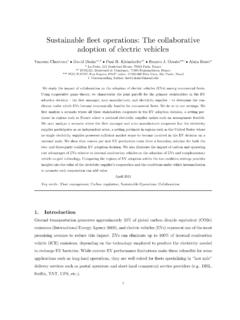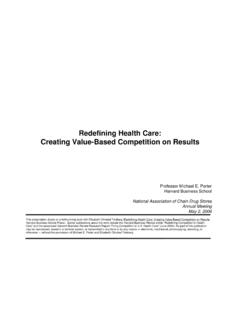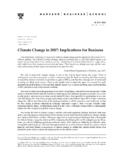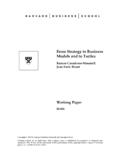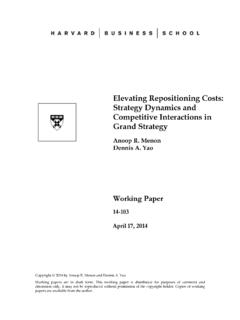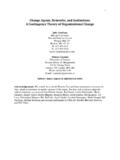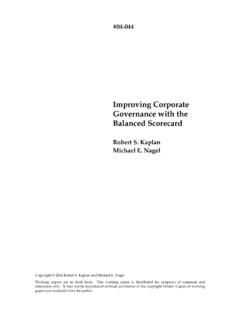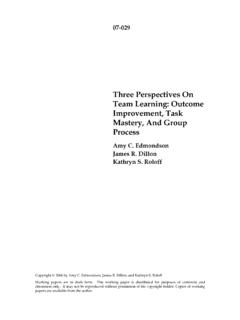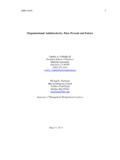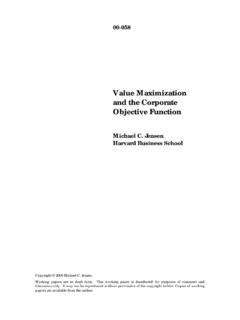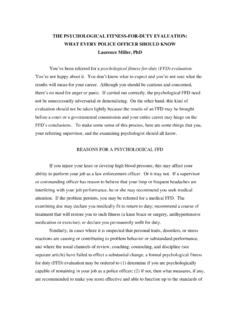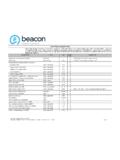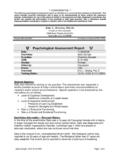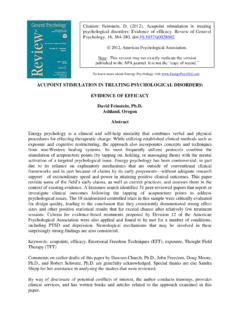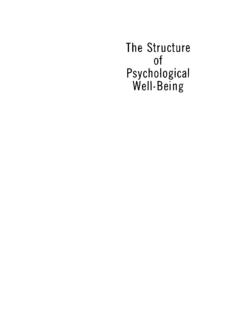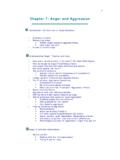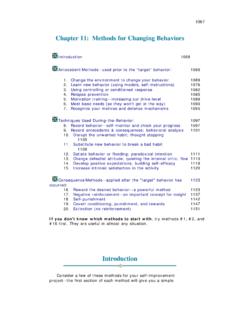Transcription of Managing the risk of learning: Psychological safety …
1 Managing the risk of learning: Psychological safety in work teams Amy C. Edmondson Associate Professor, harvard business school , Morgan Hall T93, Boston, MA 02163, USA. March 15, 2002. Forthcoming in West, M. (Ed) International Handbook of Organizational Teamwork, London: Blackwell. Abstract This social Psychological analysis explores themes of trust and collective learning in teams. I. describe interpersonal risks that can inhibit collective learning, distinguish Psychological safety from trust, and explain why Psychological safety mitigates interpersonal risks and facilitates a structured learning process in teams. Examples from field studies in several organizational settings are used to support a new theoretical model and show how leaders can help their teams manage the risks of learning.
2 1. Introduction This paper explores how members of organizational work teams can overcome the interpersonal risks they face every day at work, to help themselves, their teams and their organizations to learn. Over the past few years I have been developing a model of learning in the work group setting that stems from the underlying premise that people are (both conscious and unconscious) impression managers reluctant to engage in behaviors that could threaten the image others hold of them. Although few of us are without concern about others' impressions, our immediate social context can mitigate or exacerbate the reluctance to relax our guard. In field studies in several organizational contexts, I have found enormous differences across teams in people's willingness to engage in behavior for which the outcomes are both uncertain and potentially harmful to their image.
3 An extensive literature on organizational culture examines how norms, values and beliefs arise in organizations to reduce the anxiety people feel confronting ambiguity and uncertainty (Schein 1985). In times of significant organizational or environmental change the potential for anxiety is increased because people must take action without knowing whether things will work out as expected. Organizational culture, for all its complexity, cannot fully mitigate the anxiety and uncertainty that accompany novel behaviors or activities. For example, a team launching a new product targeted for unfamiliar customers faces considerable technical and business risk. This can provoke feelings of anxiety in the team, but these risks can be minimized by formal risk assessment methods and explicit discussion.
4 At the same time, all individuals in organizations constantly face more subtle interpersonal risks that provoke anxiety and yet tend to remain tacit and undiscussed. Some years ago I became intrigued by the small risks people face every day at work, 2. when interacting with others and facing change, uncertainty, or ambiguity. To take action in such situations involves learning behavior, including asking questions, seeking help, experimenting with unproven actions, or seeking feedback. Although these activities are associated with such desired outcomes as innovation and performance, ( , Edmondson 1999;. West 2000), engaging in them carries a risk for the individual of being seen as ignorant, incompetent, or perhaps just disruptive. Most people feel a need to manage this risk to minimize harm to their image, especially in the workplace and especially in the presence of those who formally evaluate them.
5 This is both instrumental (promotions and other valued rewards may be dependent on impressions held by bosses and others) and socio-emotional (we prefer others'. approval than disapproval). One solution to minimizing risk to one's image is simply to avoid engaging in interpersonal behaviors for which outcomes are uncertain. The problem with this solution is that it precludes learning. Another solution to create conditions in which perceived interpersonal risk is reasonably low is explored in this paper. Most people in organizations are being evaluated whether frequently or infrequently, overtly or implicitly in an ongoing way. The presence of others with more power or status makes the threat of evaluation especially salient, but it by no means disappears in the presence of peers and subordinates.
6 This salience of evaluation in organizations intensifies the problem of image risk that people also confront in every day lives (Snyder 1974; de Cremer, Snyder et al. 2001; Turnley and Bolino 2001). Here I posit four specific risks to image that people face at work: being seen as ignorant, incompetent, negative, or disruptive. Each is triggered by particular behaviors through which individuals and groups learn. First, when individuals ask questions or seek information, they run the risk of being seen as ignorant. Most of us can think of a time when we hesitated to ask a question because it 3. seemed that no one else was asking, or perhaps we believed that the information was something we were expected to know already. Second, when admitting (or simply calling attention to) mistakes, asking for help, or accepting the high probability of failure that comes with experimenting, people risk being seen as incompetent, whether in a narrow, particular domain, or more broadly.
7 Reluctance to take interpersonal risk can create physical risks in high-risk industries such as nuclear power, where admitting mistakes and asking for help may be essential for avoiding catastrophe (Weick and Roberts 1993; Carroll 1998). Similarly, this phenomenon is particularly troubling in organizations where lives are at stake, such as in hospitals. Reluctance to report mistakes in the health care setting is widely reported ( , Leape et al. 1991). Although this silence limits the ability of hospitals as organizations to improve through collective learning from mistakes, a goal most health care professionals would heartily endorse, the perceived need for impression management to protect one's professional image is extremely high in medicine. Third, to learn and improve as individuals and collectives it is essential to reflect critically on current and past performance.
8 The risk of being seen as negative often stops people from delivering critical assessments of a group or individual's performance, which limits the thoroughness and accuracy of collective reflection (Edmondson 2002). Moreover, people strive to maintain their own and others' face, a tendency that inhibits sharing negative feedback. It is well known that bad news rarely travels well up the hierarchy, such that in the presence of supervisors and bosses, the risk of being seen as negative has been shown to be more acute than it might otherwise be (Reed 1962). Fourth, to avoid disrupting or imposing upon others' time and good will, people will avoid seeking feedback, information or help (Brown 1990). In particular, individuals are often 4. reluctant to seek feedback about their performance. Despite the gains that can be obtained from feedback (Ashford and Cummings 1983), many fail to take advantage of the opportunity.
9 Although this can be driven by avoidance of the possibility of hearing something we don't want to hear, it also stems from a wish not to be seen as lacking in self-sufficiency, or as intrusive. I have used the term Psychological safety (Edmondson 1999; 2002) to capture the degree to which people perceive their work environment as conducive to taking these interpersonal risks. In psychologically safe environments, people believe that if they make a mistake others will not penalize or think less of them for it. They also believe that others will not resent or penalize them for asking for help, information or feedback. This belief fosters the confidence to take the risks described above and thereby to gain from the associated benefits of learning. I argue that creating conditions of Psychological safety is essential to laying a foundation for effective learning in organizations.
10 I further propose that structuring a collective learning process at the team or group level is a second critical element for effective organizational learning, and that a compelling goal is necessary for motivating this collective learning process. Although human beings are endowed with both desire and ability for learning, collections of interdependent individuals, whether small groups or large organizations, do not learn automatically. Not only does interpersonal risk inhibit some of the necessary behaviors, but organizational routines tend to endure and have a permanence of their own, independent of the actors who engage in them (Levitt and March 1988; Gersick and Hackman 1990). Moreover, traditions and beliefs about the appropriateness of the status quo inhibit learning and change (Levitt and March 1988).
